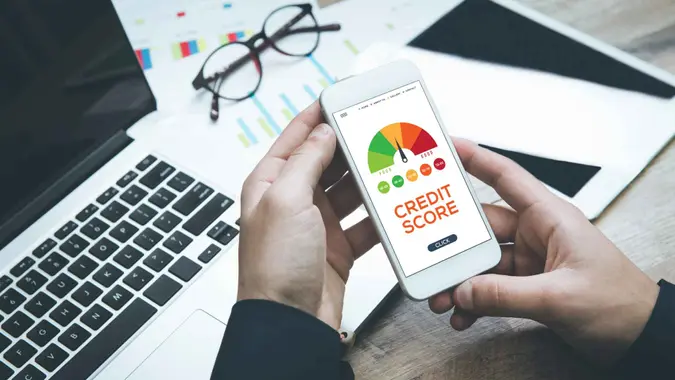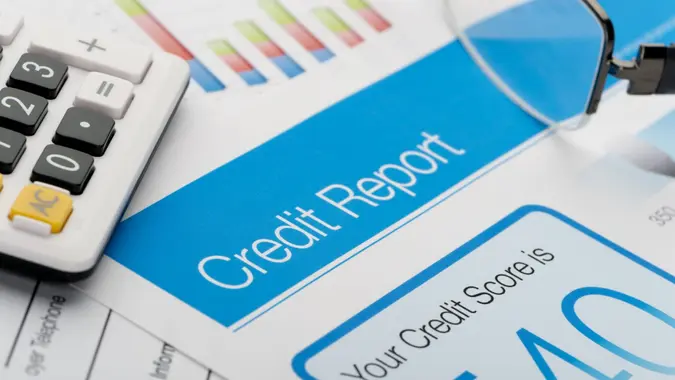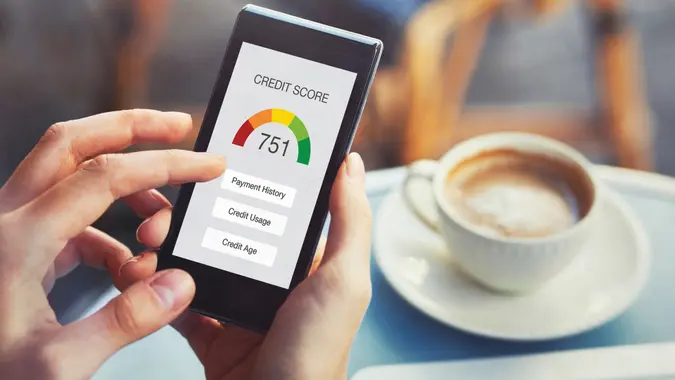Here’s What Your Credit Score Says About Your Debt

Commitment to Our Readers
GOBankingRates' editorial team is committed to bringing you unbiased reviews and information. We use data-driven methodologies to evaluate financial products and services - our reviews and ratings are not influenced by advertisers. You can read more about our editorial guidelines and our products and services review methodology.

20 Years
Helping You Live Richer

Reviewed
by Experts

Trusted by
Millions of Readers
Thanks to the Fed’s rate-raising spree, which the Central Bank initiated to curb inflation, borrowing money has become much more expensive in recent years. And, perhaps unsurprisingly, borrowers’ credit scores are reliable indicators of how much debt, and what kind of debt, they’re likely to hold.
A recent Experian study on consumer debt sheds light on the relationship between debt and creditworthiness. The results show that your score says a lot about your debt and your debt says a lot about your score.
Good Credit Fueled Much of the Recent Borrowing Bonanza
America’s consumer debt increased by 4.4% last year, from $16.38 trillion in 2022 to $17.1 trillion in 2023. Most of that debt is secured by assets that typically require stable credit to attain. For example, $11 trillion of that balance is tied to mortgage loans, which are backed by real estate. Another $1.5 trillion is for auto loans, which are secured by the vehicles they finance.
According to Quicken Loans, most lenders require a score of at least 640 for mortgages and Lending Tree says most approved car buyers have scores of 660 or above. In short, if you have asset-backed debt, you probably have at least a decent credit score.
Those With Good Credit Have More Borrowing Power — and They Use It
According to the Experian report, “Consumers with poor credit have far less overall debt than consumers with better credit scores.”
Those with strong credit profiles that are attractive to lenders tend to take on debt deliberately as part of a larger financial plan — buying a home or leasing a car, for example. Not only are they more likely to be financially stable, but high-credit borrowers get the lowest rates and most attractive terms, which further increases their borrowing power.
Low-Credit Borrowers Are Taking on Debt Much More Quickly
While high-credit borrowers hold far more overall debt, the balances of those with poor credit have “increased significantly from 2022 — more than 20%,” according to the Experian report.
The study notes that those with poor credit typically don’t borrow deliberately as part of a larger financial strategy, but out of necessity. In other words, they simply can’t afford the rapidly rising cost of everyday necessities without going into debt.
For most, it’s a double-edged sword.
The report states, “Borrowing costs for these consumers were already high when the year began and were only ratcheted higher as interest rates climbed. More of these consumers also owe additional fees due to falling behind on credit payments.”
Here’s the breakdown of how total average debt balances have risen during the era of high inflation by credit score:
- 350-579 (poor): $36,159 in 2022 to $43,584 in 2023 — 20% increase
- 580-669 (fair): $65,362 in 2022 to $68,020 in 2023 — 4.1% increase
- 670-739 (good): $95,067 in 2022 to $94,836 in 2023 — 0.2% decrease
- 740-799 (very good): $109,904 in 2022 to $108,043 — 1.7% decrease
- 800-850 (exceptional): $151,890 in 2022 to $158,839 in 2023 — 4.6% decrease
In short, those with high credit scores hold much more debt, but it’s usually debt they wanted and are better able to manage.
 Written by
Written by  Edited by
Edited by 






















